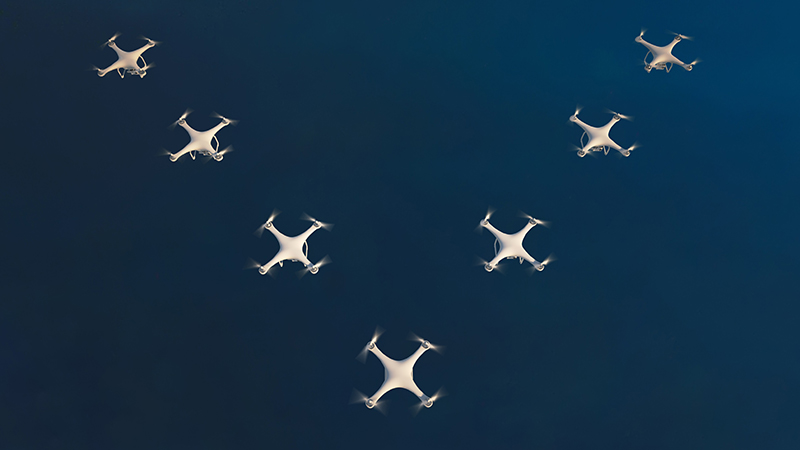

Swarm drones are a fast-growing trend in military technology. They consist of large numbers of drones that work autonomously based on a central mission set. The setup is far more complex, but this is their main appeal for militaries.
But what benefits do swarm drones have for armed forces, and why are they suddenly so in demand?
Swarm drones are a group of UAVs controlled by a central rule set. They can be manually monitored (as in the case of the Royal Army’s Atlas system) or autonomously tasked in the case of the Elbit system. Although both applications can be classified as drone swarming, autonomous swarms arguably have more potential in military applications because they allow more drones to be used.
The logic behind swarm drones comes from nature. Swarm intelligence is the collective behaviour of individual, self-controlling beings – common examples include starling murmuration and fish swarms.
We can apply swarm intelligence to UAVs by providing a simple rule set for them to follow. It includes principles of separation, alignment, and cohesion, which are built upon for specific missions. Although swarm intelligence and computer programming of this nature aren’t new, modern advances in AI algorithms and communication protocols, along with better drone technology and miniaturisation, mean we can create very impressive drone swarms.
Having a large swarm of drones – sometimes as many as 250 – has wide-ranging applications in aerospace and defence. The British Army’s tests in 2022 might have only included ten drones, but they tested autonomous missions and 24-hour perimeter defence. These cover two of the three over-arching applications for swarm drones.
In total, these are reconnaissance, electronic warfare, and coordinated strikes. Drones can be fitted with small payloads ranging from cameras and infrared sensors to radiation detectors and radio jammers.
The benefits in military scenarios should be obvious, as they’re no different from any other unmanned system. Swarm drones can enhance the capabilities of existing military assets, primarily by providing more data and flexibility in the field, and reducing the risk to human operators. After all, if we can control a large swarm remotely, this could potentially remove a lot of personnel from danger.
But there are also civilian applications to swarm drones (aside from impressive light shows). They could have far-reaching use in disaster response, search and rescue, and infrastructure inspection. As with military applications, the point would be to remove people from danger while providing greater access to data.
The challenges of swarm drones aren’t that different to other emerging military technologies. First, there’s battery life, something we have little control over with current technology. Hopefully, we will soon have batteries capable of matching the potential of swarm drones.
Then there are the issues of communication interference and misuse. If you know how a drone swarm works, there isn’t much stopping you from interfering (or taking over) control of the swarm, which has ethical considerations for how they might be employed.
Finally, there’s maintenance. While this isn’t a massive concern, it does require manpower and specialisation to look after the drones, which could take a lot of work for a swarm of 200 or more. However, a solution would be drone kits, where it’s easy to swap in broken pieces with almost no effort.
Drone swarms are still in their early stages, but the technology has a lot of potential for both military and civilian applications. Having one person in charge of a sizeable fleet of drones could be a game-changer for the future of security, and it’ll be interesting to see it develop.